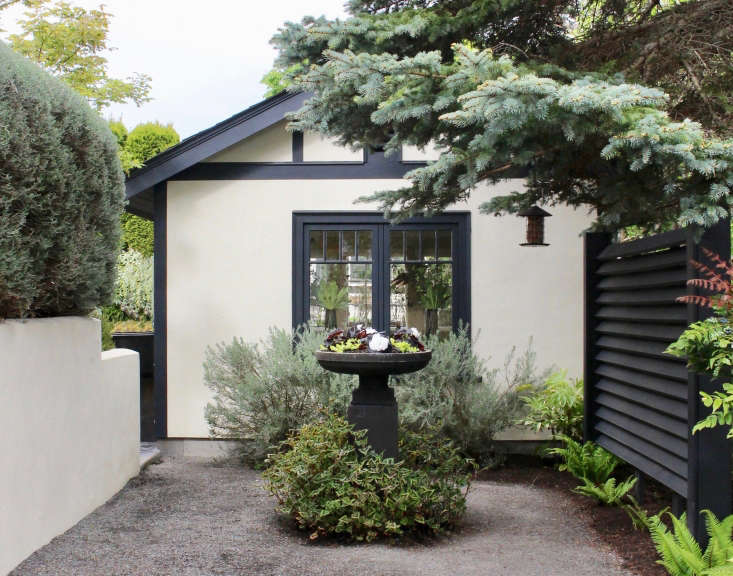The home of Barbara and Michael Gergel sits on a corner city lot in Victoria British Columbia, one block from the ocean. Victoria, on Vancouver Island, lies just below the 49th parallel separating the Canada and the U.S. The climate—if you’re feeling generous—could be called “Mediterranean” given the pattern of winter wetness and summer dryness.
But at this latitude, light, and temperature levels are low in winter, so plants rot; in summer, they suffer from drought. With such extremes in mind, designer and master gardener Barbara Gergel looked south of the equator for plants to shape her home garden.
Photography by Christin Geall, except where noted.
Entryway

The bungalow dates from 1925. “The house is stout, almost masculine,” Gergel says. “I’ve tried to replicate that feeling in the garden’s design.”
Gravel Courtyard

One of the defining features of the property is the creation of an outdoor living space between the rear of the house and Gergel’s studio. Walls enclose or define the majority of plantings, thus adding heat retention and an opportunity for Gergel to control moisture levels.

By controlling temperature and moisture, Gergel has succeed in creating a privacy hedge with Ozothamnus ‘Sussex Silver’. Gergel selected the varietal ‘Sussex Silver’ for its adaptability, but warns “it’s not a beginner hedge.” She gives it a hard pruning in late spring and again in late summer. “People let it get leggy and then give up on it. It may not last indefinitely but the silvery color makes it worth it.” Gergel has planted it within a raised wall using crushed rock under soil for drainage.

Gergel’s zone pushing includes the use of tropical staghorn ferns, Platycerium bifurcatum. As epiphytic plants, the ferns require no soil. Gergel soaks her cedar staghorn boards once a month and feeds the ferns with a bit of banana peel tucked into the moss (as a friend suggested they like potassium). She overwinters them in her unheated studio. Under the staghorns, she has planted Senecio rowleyanus, the String-of-Pearls plant, which by summer will create a draping effect.
Retaining Walls

Above: The retaining walls have been softened with plantings of succulents in moss. Here, Eleganus ‘Quicksilver’ arches over Sepervivums and Sedums.

Stairway


Gergel’s use of green unifies the garden. “I process things visually,” she says. “I try to use repetition to add harmony.”

N.B.: For more cold climate garden ideas, see:
- Native Perennials for a Shade Garden: 9 Favorites for a Cold Climate.
- 8 Cold-Climate Shrubs and Flowering Trees for Early Spring.
- Garden Visit: At Home with Canada’s Favorite Garden Writer.









Have a Question or Comment About This Post?
Join the conversation